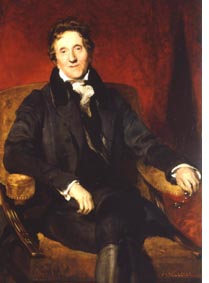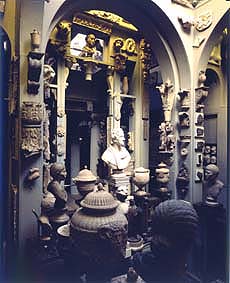Sir John Soane's Museum: London's Most Eccentric Residence
by Kavitha Rao
If you have a weakness for English eccentricity, this most eccentric of London's museums is for you. The house of the famous architect and collector Sir John Soane is a bizarre yet beguiling hotchpotch of priceless paintings, curiosities, sculptures, marbles and even an Egyptian sarcophagus. The Georgian townhouse in which they are displayed is as quirky as its contents -- a labyrinth of glittering mirrors, hidden passages, concealed skylights, and secret niches. The house also enjoys wonderful views across the greenery of Lincoln's fields -- one of London's prettiest town squares and a popular setting for duels in Soane's time.
 Born a bricklayer's son in 1753, Soane later designed several of London's most famous buildings, including the Bank of England, parts of the Houses of Parliament (which were later torn down), and the Dulwich Picture Gallery. He was also a professor of architecture at the Royal Academy. The museum was left to the nation on the condition that it be left unchanged, so everything you see is how it was when Soane lived in it.
Born a bricklayer's son in 1753, Soane later designed several of London's most famous buildings, including the Bank of England, parts of the Houses of Parliament (which were later torn down), and the Dulwich Picture Gallery. He was also a professor of architecture at the Royal Academy. The museum was left to the nation on the condition that it be left unchanged, so everything you see is how it was when Soane lived in it.
Soane, evidently, was not a fan of the "less is more" school of interior decoration. Here more is more, with paintings, sculptures and marble fragments hung all the way to the ceiling. So closely are they amassed that the walls look like they have been thickly papered with curiosities. As you walk through the house, every room has its own secret niche, startling views or bizarre decorations.
The most ingenious room in the house is the Picture Room, which cunningly displays over a hundred pictures on folding screens in a tiny space. Concealed behind the screens are two of Hogarth's satirical works, "The Rake's Progress" and "The Election", considered very racy in their day. After a sensitive lady visitor complained that the scenes of drunken men carousing with scantily clad women made her feel faint, Soane devised the concealing screens and displayed the paintings only to male visitors. Also tucked away behind sedate landscapes is Sir Richard Westmacott's nude statue of a nymph. Other priceless pictures scattered through the house include fifteen drawings of Grecian temples by the Italian artist Piranesi, and several architectural drawings by Soane and other architects of the time. Perhaps the loveliest of the paintings are three magical scenes of Venice by Canaletto, with the Grand Canal shimmering in the foreground and views of the Rialto in the distance.
 The eerie Crypt Room, designed to look like Roman catacombs, is a complete contrast. Soane was obviously something of a necrophiliac. The catacombs are crammed with Roman urns, funerary busts and other memorabilia. The crypt also displays the white alabaster sarcophagus of Pharoah Seti I, discovered in the Valley of the Kings. When Soane acquired the sarcophagus in 1824, he hosted three evening parties and invited nearly a thousand people to view the treasure. Other fascinating finds include ivory chairs seized from Tipu Sultan, the maharajah of Mysore, after his defeat by the British in 1799; and miniatures of Napoleon commissioned by the Empress Josephine. Upstairs, the Colonnade is festooned with marbles and casts rescued from various Roman and Greek ruins, including a female torso from the Acropolis and a life-size cast of the Apollo Belvedere. A bust of Soane presides over the room, looking more like a Roman senator than an architect.
The eerie Crypt Room, designed to look like Roman catacombs, is a complete contrast. Soane was obviously something of a necrophiliac. The catacombs are crammed with Roman urns, funerary busts and other memorabilia. The crypt also displays the white alabaster sarcophagus of Pharoah Seti I, discovered in the Valley of the Kings. When Soane acquired the sarcophagus in 1824, he hosted three evening parties and invited nearly a thousand people to view the treasure. Other fascinating finds include ivory chairs seized from Tipu Sultan, the maharajah of Mysore, after his defeat by the British in 1799; and miniatures of Napoleon commissioned by the Empress Josephine. Upstairs, the Colonnade is festooned with marbles and casts rescued from various Roman and Greek ruins, including a female torso from the Acropolis and a life-size cast of the Apollo Belvedere. A bust of Soane presides over the room, looking more like a Roman senator than an architect.
Soane obviously enjoyed digging deep into his architectural bag of tricks. Mirrors are scattered throughout the house to expand space, cheat the eye and make the collection appear all the larger. In fact, the large convex mirrors in one of the rooms are thought to have inspired John Tenniel's famous illustrations in Lewis Carroll's Through the Looking Glass. Ceilings are studded with skylights, domes and vaults. The light filtering through the stained glass set in the skylights is a faint yellow, chosen to make the pictures stand out better. Windows offer unexpected views of Roman marbles and fragments, and the breakfast parlour displays a delicate trompe l'oeil ceiling painted to resemble a trellis covered with honeysuckle and columbine blossoms. The furniture throughout the house is original. Look out for the desk owned by former Prime Minister Sir Robert Walpole, and Mrs Soane's original tea service laid out in the breakfast room.
There's more of Soane's whimsy in the Monk's parlour, a set of rooms in the basement of the house. They were intended for use by Padre Giovanni or Father John, a completely fictional character invented by Soane. The yard even contains the "Monk's grave" topped by a headstone engraved with the words "Alas! Poor Fanny!" The grave actually contains the corpse of Mrs Soane's beloved lap dog, Fanny.
Behind this apparently nonsensical invention lies a tragic tale. Soane was deeply disappointed by his two sons, neither of whom shared his passion for architecture. His eldest son died young. His younger son, George, was a drunken spendthrift who had to be bailed out of prison several times by his father. He later became a writer and ridiculed his father's creations in newspaper articles. After that final betrayal, Soane disinherited his son. With his influence over Queen Victoria, he got an Act of Parliament passed to ensure that his house would pass to the nation and not to his son. After his wife's death in 1815, Soane lived a lonely and solitary life in what he called his "Mansion of Woe", but he never stopped adding to his capricious collection, continuing to arrange and rearrange his treasures until his death in 1837.
When visiting the Soane museum, try to take one of the guided tours available on a Saturday. The knowledgeable tour guides display secrets of the house that are hard to discover on your own, and explain several fascinating facts about the house.
- Sir John Soane's Museum
- 13 Lincoln's Fields London WC 2A 3 BP. Nearest tube: Holborn.
- Tel: 44 020 74052107
- http://www.soane.org
- Open Tuesday to Saturday, 10 am to 5pm. Also on the first Tuesday of each month, 6 to 9pm. Admission is free. Public lecture tour every Saturday at 2.30 pm. Tickets £3.
More Information:
We regret that we no longer have the resources to maintain up-to-date links and/or hours and pricing details for the various sites and attractions listed on this website. For more information about the location(s) listed above, please use your favorite search engine or visit Wikipedia.
Kavitha Rao is a freelance writer who has lived and worked in Mumbai, Bangkok, Hong Kong and Tokyo. She currently lives in London, and doesn't think she will ever tire of it. Her articles on culture, travel, literature and lifestyles have appeared in the Daily Telegraph, Asiaweek, the South China Morning Post and the Far Eastern Economic Review, among others.
Article © 2005 Kavitha Rao
Photos courtesy of Sir John Soane Museum
|
